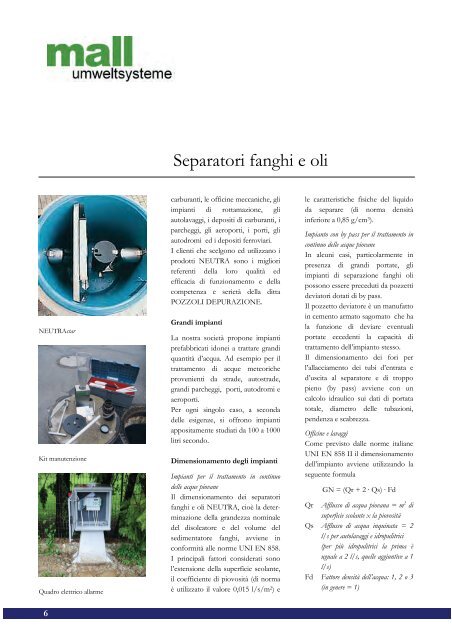Impianti di depurazione delle acque reflue - Comip.it
Impianti di depurazione delle acque reflue - Comip.it
Impianti di depurazione delle acque reflue - Comip.it
Create successful ePaper yourself
Turn your PDF publications into a flip-book with our unique Google optimized e-Paper software.
NEUTRAstar<br />
K<strong>it</strong> manutenzione<br />
Quadro elettrico allarme<br />
6<br />
Separatori fanghi e oli<br />
carburanti, le officine meccaniche, gli<br />
impianti <strong>di</strong> rottamazione, gli<br />
autolavaggi, i depos<strong>it</strong>i <strong>di</strong> carburanti, i<br />
parcheggi, gli aeroporti, i porti, gli<br />
autodromi ed i depos<strong>it</strong>i ferroviari.<br />
I clienti che scelgono ed utilizzano i<br />
prodotti NEUTRA sono i migliori<br />
referenti della loro qual<strong>it</strong>à ed<br />
efficacia <strong>di</strong> funzionamento e della<br />
competenza e serietà della <strong>di</strong>tta<br />
POZZOLI DEPURAZIONE.<br />
Gran<strong>di</strong> impianti<br />
La nostra società propone impianti<br />
prefabbricati idonei a trattare gran<strong>di</strong><br />
quant<strong>it</strong>à d’acqua. Ad esempio per il<br />
trattamento <strong>di</strong> <strong>acque</strong> meteoriche<br />
provenienti da strade, autostrade,<br />
gran<strong>di</strong> parcheggi, porti, autodromi e<br />
aeroporti.<br />
Per ogni singolo caso, a seconda<br />
<strong>delle</strong> esigenze, si offrono impianti<br />
appos<strong>it</strong>amente stu<strong>di</strong>ati da 100 a 1000<br />
l<strong>it</strong>ri secondo.<br />
Dimensionamento degli impianti<br />
<strong>Impianti</strong> per il trattamento in continuo<br />
<strong>delle</strong> <strong>acque</strong> piovane<br />
Il <strong>di</strong>mensionamento dei separatori<br />
fanghi e oli NEUTRA, cioè la determinazione<br />
della grandezza nominale<br />
del <strong>di</strong>soleatore e del volume del<br />
se<strong>di</strong>mentatore fanghi, avviene in<br />
conform<strong>it</strong>à alle norme UNI EN 858.<br />
I principali fattori considerati sono<br />
l’estensione della superficie scolante,<br />
il coefficiente <strong>di</strong> piovos<strong>it</strong>à (<strong>di</strong> norma<br />
è utilizzato il valore 0,015 l/s/m 2 ) e<br />
le caratteristiche fisiche del liquido<br />
da separare (<strong>di</strong> norma dens<strong>it</strong>à<br />
inferiore a 0,85 g/cm 3 ).<br />
Impianto con by pass per il trattamento in<br />
continuo <strong>delle</strong> <strong>acque</strong> piovane<br />
In alcuni casi, particolarmente in<br />
presenza <strong>di</strong> gran<strong>di</strong> portate, gli<br />
impianti <strong>di</strong> separazione fanghi oli<br />
possono essere preceduti da pozzetti<br />
deviatori dotati <strong>di</strong> by pass.<br />
Il pozzetto deviatore è un manufatto<br />
in cemento armato sagomato che ha<br />
la funzione <strong>di</strong> deviare eventuali<br />
portate eccedenti la capac<strong>it</strong>à <strong>di</strong><br />
trattamento dell’impianto stesso.<br />
Il <strong>di</strong>mensionamento dei fori per<br />
l’allacciamento dei tubi d’entrata e<br />
d’usc<strong>it</strong>a al separatore e <strong>di</strong> troppo<br />
pieno (by pass) avviene con un<br />
calcolo idraulico sui dati <strong>di</strong> portata<br />
totale, <strong>di</strong>ametro <strong>delle</strong> tubazioni,<br />
pendenza e scabrezza.<br />
Officine e lavaggi<br />
Come previsto dalle norme <strong>it</strong>aliane<br />
UNI EN 858 II il <strong>di</strong>mensionamento<br />
dell’impianto avviene utilizzando la<br />
seguente formula<br />
GN = (Qr + 2 · Qs) · Fd<br />
Qr Afflusso <strong>di</strong> acqua piovana = m 2 <strong>di</strong><br />
superficie scolante x la piovos<strong>it</strong>à<br />
Qs Afflusso <strong>di</strong> acqua inquinata = 2<br />
l/s per autolavaggi e idropul<strong>it</strong>rici<br />
(per più idropul<strong>it</strong>rici la prima è<br />
uguale a 2 l/s, quelle aggiuntive a 1<br />
l/s)<br />
Fd Fattore dens<strong>it</strong>à dell’acqua: 1, 2 o 3<br />
(in genere = 1)



